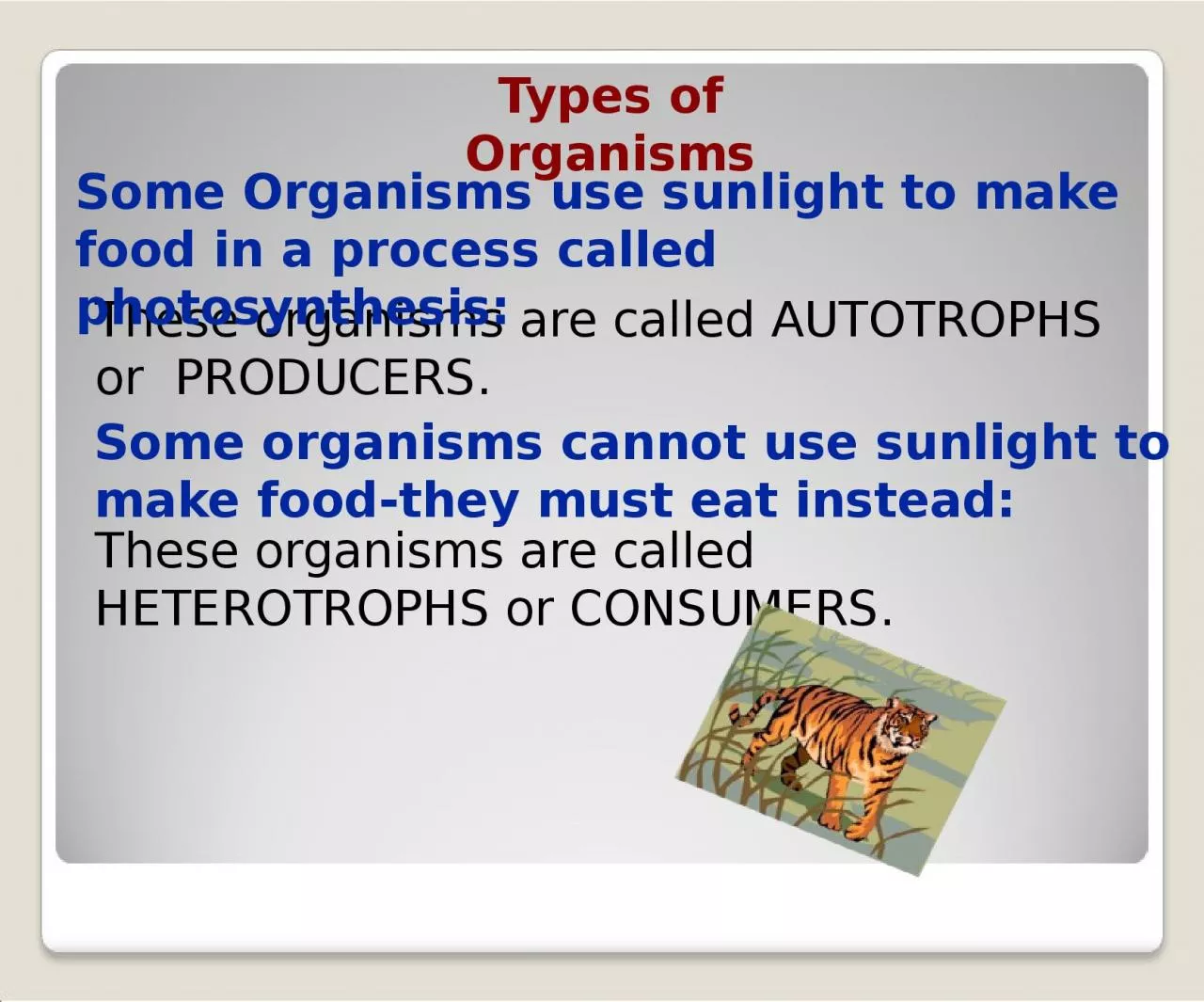

These organisms are called HETEROTROPHS or CONSUMERS Some Organisms use sunlight to make food in a process called photosynthesis Some organisms cannot use sunlight to make foodthey ID: 1033191
Download Presentation The PPT/PDF document "These organisms are called AUTOTROPHS o..." is the property of its rightful owner. Permission is granted to download and print the materials on this web site for personal, non-commercial use only, and to display it on your personal computer provided you do not modify the materials and that you retain all copyright notices contained in the materials. By downloading content from our website, you accept the terms of this agreement.
1. These organisms are called AUTOTROPHS or PRODUCERS.These organisms are called HETEROTROPHS or CONSUMERS. Some Organisms use sunlight to make food in a process called photosynthesis:Some organisms cannot use sunlight to make food-they must eat instead:Types of Organisms
2. Cellular RespirationNo matter how organisms get their food ALL get their energy FROM THE FOOD in the SAME way.Types of Organisms
3. Cellular Respiration is a Process in which organisms create ATP from the food they make or eat.Cellular Respiration
4. During Cellular Respiration we take potential energy (stored energy) called chemical energy stored in the bonds of glucose and turn it into ATP.ATP is called free energy because it is available to do any type of work needed in our cells called Kinetic Energy (energy available for work)The amount of energy released is measure in calories or kilocaloriesThe more energy a type of food can release the more calories it hasCellular Respiration
5. Cellular Respiration: catabolic, exergonic, aerobic process that uses energy to extract ATP (adenosine triphosphate) from an organic molecule called glucoseCatabolic: breaks molecules downExergonic: releases energyAerobic: oxygen (O2) requiringCellular Respiration
6. Cellular Respiration is similar to breathing and respirationBreathing and respiration is an exchange of oxygen and carbon dioxide between blood and the outside airCellular respiration is the exchange of oxygen and carbon dioxide between the cells and the bloodCellular Respiration
7. Cellular RespirationCellular Respiration uses the glucose we eat and the glucose plants make as well as the oxygen we breathe to create up to 38 ATP as well as the carbon dioxide we breathe out and water.Makes up to 38 ATP
8. What is ATP?Adenosine Tri-Phospate:Made of three things1.) Ribose (sugar)2.) Adenosine (base)3.) Three phosphatesKey to the activity of ATP is release energy as the bonds break between the phosphates
9. ATP to ADP To ADP releases energyAMP ADP ATP
10. Cellular Respiration takes place in three stages and in different places of the cell.Glycolysis: Cytoplasm (cytosol)Mitochondrial Krebs Cycle: Mitochondrial MatrixElectron Transport Chain: Inner Mitochondrial MembraneCellular Respiration
11. Cellular Respiration: MitochondriaThe mitochondria is designed to complete cellular respiration with maximum energy production. > There are many folds in the membrane to increase surface area and allows many reactions of Cellular Respiration to occur at once. This produces a lot of ATP.
12. Cellular RespirationCellular Respiration is broken into three main parts.1.) Glycolysis: sugar splitting phase (glucose is the sugar)2.) Krebs Cycle (Citric Acid Cycle): Extracts the energy from glucose3.) Electron Transport Chain/ATP Synthase: Turns the energy into ATP for the body to use *In total makes from 34 to 38 ATP**
13. Stage 1: GlycolysisLocation: Occurs in the cytoplasm just outside of mitochondria in two phases.A. Energy investment phasePut 2 ATP in to start the reactionB. Energy yielding phaseCreate 4 ATPMAIN GOAL: To split glucose
14. GlycolysisProcess:Invest 2 ATP to start the reactionSplit glucose molecule in half to create two molecules of Pyruvic Acid Produces two molecules of NADH from NAD+Produces 4 new ATP moleculesNET GAIN: 2 ATP (4 Produced - 2 Invested)
15. GlycolysisReactants2 ATP Molecules1 Glucose Molecule2 NAD+ Molecules4 ADP MoleculesProducts2 ADP Molecules2 Pyruvate Molecules2 NADH Molecules4 ATP Molecules
16. Krebs Cycle (Citric Acid Cycle)Location: Mitochondrial MatrixMain Goal: Break down pyruvate to carbon dioxide and release more energyProcess:Diffuse pyruvic acid into the matrix of the mitochondriaEach pyruvate loses one carbon and makes a 2 carbon molecule called Acetyl CoAThe carbon join with the oxygen (aerobic) that breathe in to create the carbon dioxide we breathe outAcetyl CoA now enters the mitochondria
17. Krebs Cycle (Citric Acid Cycle)Since there are two molecules of Pyruvic Acid entering the krebs cycle there must be two turns of the cycle. One for each pyruvate.1.2.
18. Krebs Cycle (Citric Acid Cycle)Reactants:Products from glycolysisPyruvate to Acetyl CoAADPOxygenFADNAD+Products:4 Carbon Molecule to be recycledATPCarbon DioxideFADH2NADH
19. Electron Transport ChainLocation: Inner Membranes of MitochondriaMain Goal: Use hydrogen ions and electrons to make up to 34 ATPProcess: -All NADH and FADH2 are electron carrier molecules - Made from glycolysis and krebs cycle NADH and FADH2 donate electrons and hydrogen ions to make ATP
20. Electron Transport ChaineReactants:ALL NADH and FADH2 from glycolysis and the krebs cycleADPProducts:NAD+ and FADATP
21. FermentationIn some cases there is little to no oxygen present and organisms still need energy. Since cellular respiration is an aerobic process it cannot occur with out oxygen. -Fermentation occurs when no oxygen is present (anaerobic) -Two Types 1. Lactic Acid: Completes glycolysis and produces lactic acid 2. Alcoholic: Completes glycolysis and produces alcohol